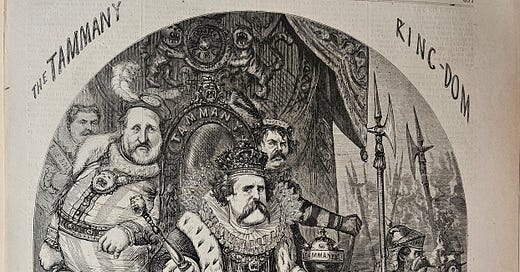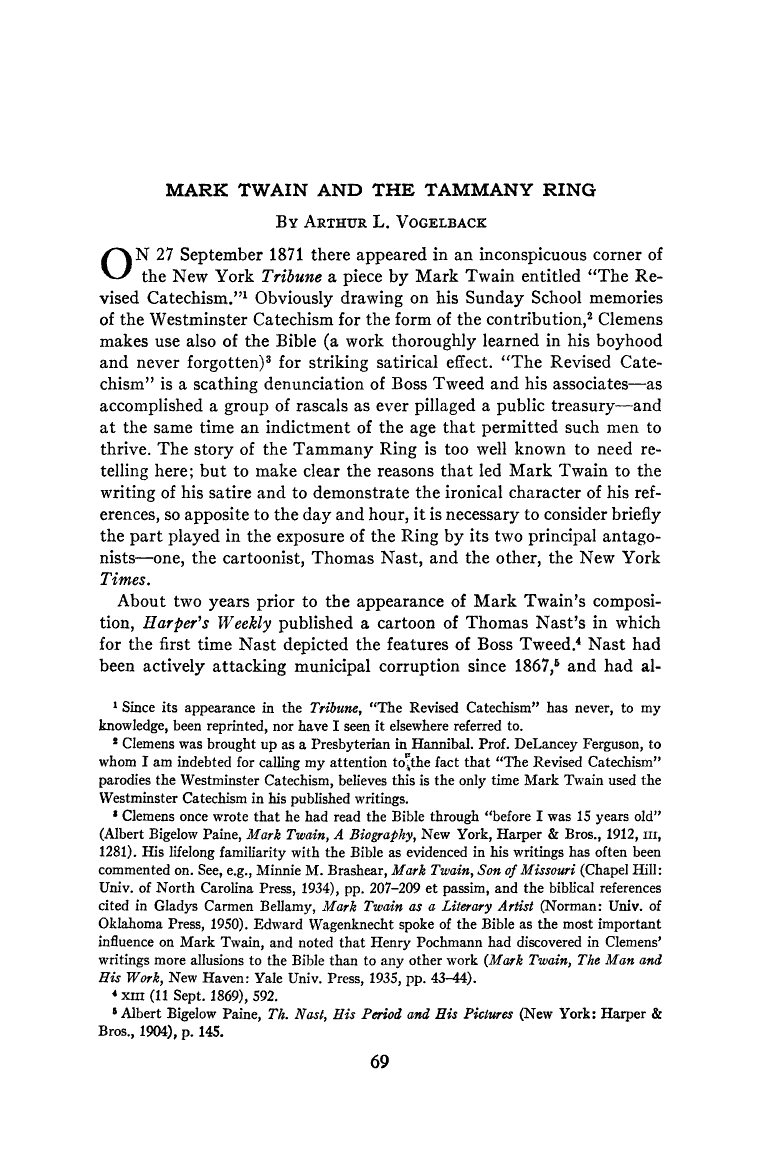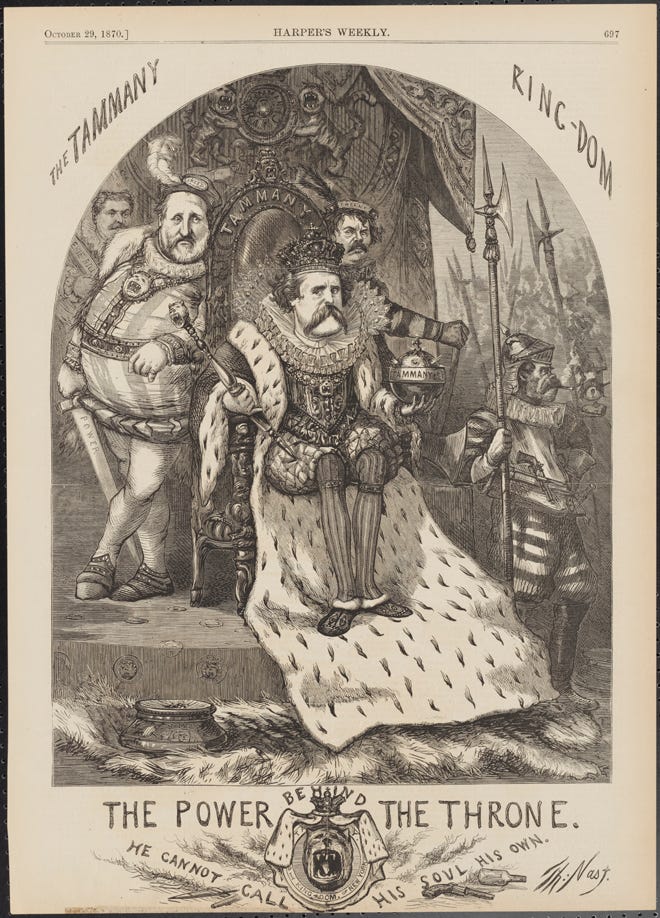Tammany/Boss Tweed––to left of throne––on Harper's Weekly cover/Oct. 29, 1870. (Great photo of artist Thomas Nast, drawing at his desk 1880 (scroll down).
https://en.wikipedia.org/wiki/William_M._Tweed
THE POWER BEHIND THE THRONE.
From “Nast Cartoons”
Nast knew that ridicule was probably the only effective way to attack the Ring, but there was no obvious approach. Tweed, Sweeny, Hall and Hoffman all had positive public images, while the press was largely controlled. Tammany excelled at keeping mouths and records closed, so meaningful information was hard to come by. In fact, until late 1870, Nast appeared unsure whether Tweed or Sweeny had the ultimate power within the Ring.
Shortly before that year’s election, Tweed made his first cartoon appearance in five months (Nast had been focusing on other topics). Now Tweed was the unmistakable Power Behind the Throne, although their respective headbands said “Sweed” and “Tweeny.” Nast turned the Tammany Kingdom into “Ringdom” by doctoring the K.
As a wary King Hoffman sat on his throne, Nast reminded him that “he cannot call his soul his own.” The Tammany Tiger evolved into a sharp-toothed snarler, and was the centerpiece in the royal seal of the “Kingdom of New York.”
Connection between Mark. Twain and Thomas Nast—fighting Tammany Hall. This is ‘A Preview,’ that only runs the first page (From Cambridge UNiversity Press):
From "Thomas Nast takes Down Tammany, by Anne DiFabio
As the election cycle gets into full-swing, so do the pundits, journalists, and political cartoonists. While modern readers intrinsically link newspapers and political cartoons, the use of cartoons in the American media was minimal until Thomas Nast popularized them in the 1860s and 1870s. Known today as the father of American political cartoons, Nast gained fame as a cartoonist for Harper’s Magazine. Today he is best remembered for his cartoons about Boss Tweed and the Tammany Ring.
Tammany Hall was a New York City political organization that originated in the late 18th century. It became the Democratic Party’s political “machine” and thus controlled the party’s nominations. William M. Tweed, more commonly known as Boss Tweed, was a New York politician who became Tammany’s leader in the late 1860’s. As the party’s boss, he was able to appoint several city officials and essentially controlled the city government. As a result, he had access to an enormous amount of public money, which he used to enrich himself and his closest friends and allies through a variety of money laundering and profit sharing operations. It is estimated that he defrauded the city out of anywhere from $30 million to $200 million dollars (equivalent to $365 million to $2.4 billion today).
Tweed certainly had his supporters, including the large Irish immigrant population that made up his base. Under his lead, however, Tammany’s corruption was so vast and glaring – Tweed became known for wearing a large diamond in his shirtfront and lived in a mansion on Fifth Avenue – that he earned a wide range of critics. One of his most vocal critics was Thomas Nast, who featured Tweed and his cronies in many of his cartoons, particularly in 1870 and 1871.
Thomas Nast was a German immigrant who began his career illustrating newspapers and magazines, but eventually began creating political cartoons. Rising through the social and economic ranks, Nast embodied the American dream. He was a staunch advocate for municipal reform, and Tweed’s corruption fundamentally insulted his sense of equity.
[William M. Tweed.] Sarony & Co., ca. 1869. Portrait Archive. Museum of the City of New York. 41.366.30
Thomas Nast (1840-1902). The Power Behind the Throne “He Cannot Call His Soul His Own.” 1870. Museum of the City of New York. 99.124.7
Never afraid to take on issues of right and wrong, Nast became the scourge of Tweed and Tammany. His influence was so great primarily because of the visual nature of his work. Most of Tweed’s constituents were illiterate, so while they couldn’t read the scathing articles written about Tweed in The New York Times, they could understand Nast’s cartoons. Legend has it that Tweed was so threatened by Nast, he gave orders to “stop them damn pictures!”
————
————







![[William M. Tweed.] Sarony & Co., ca. 1869. Portrait Archive. Museum of the City of New York. 41.366.30 [William M. Tweed.] Sarony & Co., ca. 1869. Portrait Archive. Museum of the City of New York. 41.366.30](https://substackcdn.com/image/fetch/$s_!X3t1!,w_1456,c_limit,f_auto,q_auto:good,fl_progressive:steep/https%3A%2F%2Fsubstack-post-media.s3.amazonaws.com%2Fpublic%2Fimages%2F2450b008-f04b-4cb6-b311-c7fdc847e368_660x918.jpeg)


Loved the photo of Nast at work, the "clutter" on the desk. Also fun to read that Mark Twain read the Bible through from cover-to-cover, which proved useful to his creativity. As a former Biblical Literature major in college (read the Bible through 5 times) I understand this, especially given the influence of The Book on Western Civilization. (As a footnote, when I discovered Tom Robbins, whose grandfathers were both So. Baptist ministers, I so admired his humor-laced take on spirituality and Christianity that I made sure to read all 8 of his novels through 6 times.)